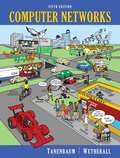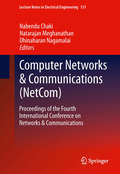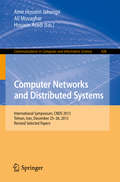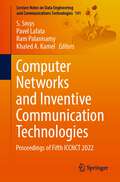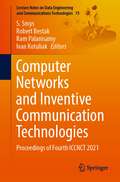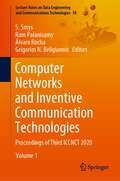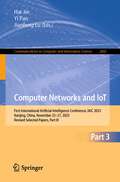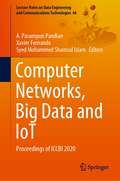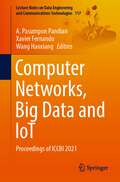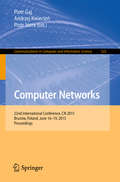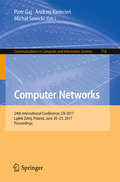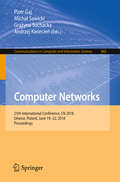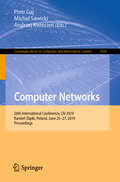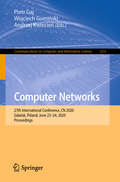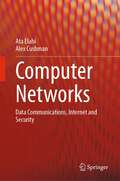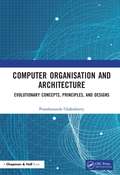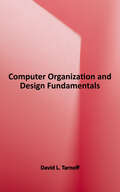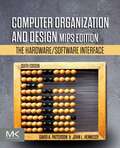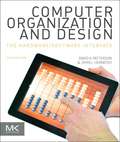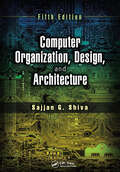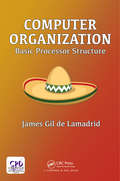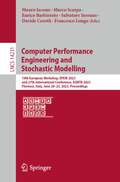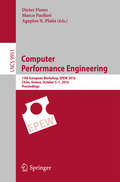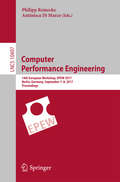- Table View
- List View
Computer Networks
by Andrew Tanenbaum David WetherallAppropriate for Computer Networking or Introduction to Networking courses at both the undergraduate and graduate level in Computer Science, Electrical Engineering, CIS, MIS, and Business Departments. <p> Tanenbaum takes a structured approach to explaining how networks work from the inside out. He starts with an explanation of the physical layer of networking, computer hardware and transmission systems; then works his way up to network applications. Tanenbaum's in-depth application coverage includes email; the domain name system; the World Wide Web (both client- and server-side); and multimedia (including voice over IP, Internet radio video on demand, video conferencing, and streaming media. Each chapter follows a consistent approach: Tanenbaum presents key principles, then illustrates them utilizing real-world example networks that run through the entire book--the Internet, and wireless networks, including Wireless LANs, broadband wireless and Bluetooth. The Fifth Edition includes a chapter devoted exclusively to network security. The textbook is supplemented by a Solutions Manual, as well as a Website containing PowerPoint slides, art in various forms, and other tools for instruction, including a protocol simulator whereby students can develop and test their own network protocols.
Computer Networks & Communications: Proceedings of the Fourth International Conference on Networks & Communications (Lecture Notes in Electrical Engineering #131)
by Nabendu Chaki Natarajan Meghanathan Dhinaharan NagamalaiComputer Networks & Communications (NetCom) is the proceedings from the Fourth International Conference on Networks & Communications. This book covers theory, methodology and applications of computer networks, network protocols and wireless networks, data communication technologies, and network security. The proceedings will feature peer-reviewed papers that illustrate research results, projects, surveys and industrial experiences that describe significant advances in the diverse areas of computer networks & communications.
Computer Networks and Distributed Systems: International Symposium, CNDS 2013, Tehran, Iran, December 25-26, 2013, Revised Selected Papers (Communications in Computer and Information Science #428)
by Amir Hossein Jahangir Ali Movaghar Hossein AsadiThis book constitutes the refereed proceedings of the International Symposium on Computer Networks and Distributed Systems, CNDS 2013, held in Tehran, Iran, in December 2013. The 14 full papers presented were carefully reviewed and selected from numerous submissions. They are organized in topical sections such as cognitive and multimedia networks; wireless sensor networks; security; clouds and grids.
Computer Networks and Inventive Communication Technologies: Proceedings of Fifth ICCNCT 2022 (Lecture Notes on Data Engineering and Communications Technologies #141)
by S. Smys Pavel Lafata Ram Palanisamy Khaled A. KamelThis book is a collection of peer-reviewed best selected research papers presented at 5th International Conference on Computer Networks and Inventive Communication Technologies (ICCNCT 2022). The book covers new results in theory, methodology, and applications of computer networks and data communications. It includes original papers on computer networks, network protocols and wireless networks, data communication technologies, and network security. The proceedings of this conference is a valuable resource, dealing with both the important core and the specialized issues in the areas of next generation wireless network design, control, and management, as well as in the areas of protection, assurance, and trust in information security practice. It is a reference for researchers, instructors, students, scientists, engineers, managers, and industry practitioners for advance work in the area.
Computer Networks and Inventive Communication Technologies: Proceedings of Fourth ICCNCT 2021 (Lecture Notes on Data Engineering and Communications Technologies #75)
by S. Smys Robert Bestak Ivan Kotuliak Ram PalanisamyThis book is a collection of peer-reviewed best-selected research papers presented at 4th International Conference on Computer Networks and Inventive Communication Technologies (ICCNCT 2021). The book covers new results in theory, methodology, and applications of computer networks and data communications. It includes original papers on computer networks, network protocols and wireless networks, data communication technologies, and network security. The proceedings of this conference are a valuable resource, dealing with both the important core and the specialized issues in the areas of next-generation wireless network design, control, and management, as well as in the areas of protection, assurance, and trust in information security practice. It is a reference for researchers, instructors, students, scientists, engineers, managers, and industry practitioners for advanced work in the area.
Computer Networks and Inventive Communication Technologies: Proceedings of Third ICCNCT 2020 (Lecture Notes on Data Engineering and Communications Technologies #58)
by Álvaro Rocha S. Smys Ram Palanisamy Grigorios N. BeligiannisThis book is a collection of peer-reviewed best selected research papers presented at 3rd International Conference on Computer Networks and Inventive Communication Technologies (ICCNCT 2020). The book covers new results in theory, methodology, and applications of computer networks and data communications. It includes original papers on computer networks, network protocols and wireless networks, data communication technologies, and network security. The proceedings of this conference is a valuable resource, dealing with both the important core and the specialized issues in the areas of next generation wireless network design, control, and management, as well as in the areas of protection, assurance, and trust in information security practice. It is a reference for researchers, instructors, students, scientists, engineers, managers, and industry practitioners for advance work in the area.
Computer Networks and IoT: First International Artificial Intelligence Conference, IAIC 2023, Nanjing, China, November 25–27, 2023, Revised Selected Papers, Part III (Communications in Computer and Information Science #2060)
by Yi Pan Hai Jin Jianfeng LuThis 3-volume set, CCIS 2058-2060 constitutes the First International Conference, on Artificial Intelligence, IAIC 2023, held in Nanjing, China, in November 2023. The 85 full papers presented were carefully reviewed and selected from 428 submissions. The papers are clustered in parts on: Artificial Intelligence and Machine Learning; Data Security and information Security; Computer Networks and IoT. The papers present recent research and developments in artificial intelligence and its applications in machine learning, natural language processing, computer vision, robotics, and ethical considerations.
Computer Networks, Big Data and IoT: Proceedings of ICCBI 2020 (Lecture Notes on Data Engineering and Communications Technologies #66)
by Xavier Fernando A. Pasumpon Pandian Syed Mohammed Shamsul IslamThis book presents best selected research papers presented at the International Conference on Computer Networks, Big Data and IoT (ICCBI 2020), organized by Vaigai College Engineering, Madurai, Tamil Nadu, India, during 15–16 December 2020. The book covers original papers on computer networks, network protocols and wireless networks, data communication technologies and network security. The book is a valuable resource and reference for researchers, instructors, students, scientists, engineers, managers and industry practitioners in those important areas.
Computer Networks, Big Data and IoT: Proceedings of ICCBI 2021 (Lecture Notes on Data Engineering and Communications Technologies #117)
by Xavier Fernando A. Pasumpon Pandian Wang HaoxiangThis book presents best selected research papers presented at the International Conference on Computer Networks, Big Data and IoT (ICCBI 2021), organized by Vaigai College Engineering, Madurai, Tamil Nadu, India, during December 9–10, 2021. The book covers original papers on computer networks, network protocols and wireless networks, data communication technologies and network security. The book is a valuable resource and reference for researchers, instructors, students, scientists, engineers, managers and industry practitioners in those important areas.
Computer Networks: 22nd International Conference, CN 2015, Brunów, Poland, June 16-19, 2015. Proceedings (Communications in Computer and Information Science #522)
by Piotr Gaj Andrzej Kwiecień Piotr SteraThis book constitutes the thoroughly refereed proceedings of the 23rd International Conference on Computer Networks, CN 2016, held in Brunów, Poland, in June 2016. The 32 full papers and the 4 short papers presented were carefully reviewed and selected from 72 submissions. They are organized in topical sections on computer networks architectures and protocols, teleinformatics and telecommunications, new technologies, queueing theory, and innovative applications.
Computer Networks: 24th International Conference, CN 2017, Lądek Zdrój, Poland, June 20–23, 2017, Proceedings (Communications in Computer and Information Science #718)
by Piotr Gaj Andrzej Kwiecień Michał SawickiThe continuous and intensive development of computer science results in the fast progress of computer networks. Computer networks, as well as the entire computer science ?eld, are subject to regular changes caused by the general development of technology, and also the in?uence of new computer science te- nology. This progress refers to the methods as well as the tools of designing and modelingcomputernetworks. Particularly,therangeofusingcomputernetworks permanently is extended thanks to the results of new research and new app- cations, which were not even taken into consideration in the past. These new applications stimulate the development of scienti?c research, because the wider use of system solutions based on computer networks results in both theoretical and practical problems. This book is the evidence of the above considerations, with particular chapters referring to the broad spectrum of issues and problems. This book is the result of the research of scientists from many remarkable scienti?c research centers. It was created as a collection of articles presented during the 17th edition of the International Conference 'Computer Networks', which took place in Ustro? (Poland) during June 15-19, 2010. This conference, organized continuously since 1994 by the Institute of Informatics of Silesian University of Technology, is the oldest event of this kind organized in Poland, having an international status for three years. This year's edition like last year, took place under the auspices of IEEE Poland Section.
Computer Networks: 25th International Conference, CN 2018, Gliwice, Poland, June 19-22, 2018, Proceedings (Communications in Computer and Information Science #860)
by Piotr Gaj Andrzej Kwiecień Michał Sawicki Grażyna SuchackaThis book constitutes the thoroughly refereed proceedings of the 25th International Conference on Computer Networks, CN 2018, held in Gliwice, Poland, in June 2018. The 34 full papers presented were carefully reviewed and selected from 86 submissions. They are organized in topical sections on computer networks; teleinformatics and telecommunications; queueing theory; cybersecurity and quality service.
Computer Networks: 26th International Conference, CN 2019, Kamień Śląski, Poland, June 25–27, 2019, Proceedings (Communications in Computer and Information Science #1039)
by Piotr Gaj Andrzej Kwiecień Michał SawickiThis book constitutes the thoroughly refereed proceedings of the 26th International Conference on Computer Networks, CN 2019, held in Gliwice, Poland, in June 2019. The 29 full papers presented were carefully reviewed and selected from 64 submissions. They are organized in topical sections on computer networks; communications; and queueing theory and queuing networks.
Computer Networks: 27th International Conference, CN 2020, Gdańsk, Poland, June 23–24, 2020, Proceedings (Communications in Computer and Information Science #1231)
by Piotr Gaj Andrzej Kwiecień Wojciech GumińskiThis book constitutes the thoroughly refereed proceedings of the 27th International Conference on Computer Networks, CN 2020, held in June 2020. Due to the COVID-19 pandemic the conference was held virtually. The 14 full papers presented were carefully reviewed and selected from 34 submissions. They are organized according to the topical sections on computer networks; cybersecurity and quality of service; queueing theory and queueing networks.
Computer Networks: Data Communications, Internet and Security
by Ata Elahi Alex CushmanThe hands-on textbook covers both the theory and applications of data communications, the Internet, and network security technology, following the ACM guideline for courses in networking. The content is geared towards upper undergraduate and graduate students in information technology, communications engineering, and computer science. The book is divided into three sections: Data Communications, Internet Architecture, and Network Security. Topics covered include flow control and reliable transmission; modulation, DSL, cable modem, and FTTH; Ethernet and Fast Ethernet; gigabit and 10 gigabit Ethernet; and LAN interconnection devices, among others. The book also covers emerging topics such as IPv6 and software defined networks. The book is accompanied with a lab manual which uses Wireshark, Cisco Packet Tracer, and virtual machines to lead students through simulated labs.
Computer Organisation and Architecture: Evolutionary Concepts, Principles, and Designs
by Pranabananda ChakrabortyComputer organization and architecture is becoming an increasingly important core subject in the areas of computer science and its applications, and information technology constantly steers the relentless revolution going on in this discipline. This textbook demystifies the state of the art using a simple and step-by-step development from traditional fundamentals to the most advanced concepts entwined with this subject, maintaining a reasonable balance among various theoretical principles, numerous design approaches, and their actual practical implementations. Being driven by the diversified knowledge gained directly from working in the constantly changing environment of the information technology (IT) industry, the author sets the stage by describing the modern issues in different areas of this subject. He then continues to effectively provide a comprehensive source of material with exciting new developments using a wealth of concrete examples related to recent regulatory changes in the modern design and architecture of different categories of computer systems associated with real-life instances as case studies, ranging from micro to mini, supermini, mainframes, cluster architectures, massively parallel processing (MPP) systems, and even supercomputers with commodity processors. Many of the topics that are briefly discussed in this book to conserve space for new materials are elaborately described from the design perspective to their ultimate practical implementations with representative schematic diagrams available on the book’s website. Key Features Microprocessor evolutions and their chronological improvements with illustrations taken from Intel, Motorola, and other leading families Multicore concept and subsequent multicore processors, a new standard in processor design Cluster architecture, a vibrant organizational and architectural development in building up massively distributed/parallel systems InfiniBand, a high-speed link for use in cluster system architecture providing a single-system image FireWire, a high-speed serial bus used for both isochronous real-time data transfer and asynchronous applications, especially needed in multimedia and mobile phones Evolution of embedded systems and their specific characteristics Real-time systems and their major design issues in brief Improved main memory technologies with their recent releases of DDR2, DDR3, Rambus DRAM, and Cache DRAM, widely used in all types of modern systems, including large clusters and high-end servers DVD optical disks and flash drives (pen drives) RAID, a common approach to configuring multiple-disk arrangements used in large server-based systems A good number of problems along with their solutions on different topics after their delivery Exhaustive material with respective figures related to the entire text to illustrate many of the computer design, organization, and architecture issues with examples are available online at http://crcpress.com/9780367255732 This book serves as a textbook for graduate-level courses for computer science engineering, information technology, electrical engineering, electronics engineering, computer science, BCA, MCA, and other similar courses.
Computer Organization and Design Fundamentals: Examining Computer Hardware from the Bottom to the Top
by David L. TarnoffComputer Organization and Design Fundamentals take the reader from the basic design principles of the modern digital computer to a top-level examination of its architecture. This book can serve either as a textbook to an introductory course on computer hardware or as the basic text for the aspiring geek who wants to learn about digital design. The material is presented in four parts. The first part describes how computers represent and manipulate numbers. The second part presents the tools used at all levels of binary design. The third part introduces the reader to computer system theory with topics such as memory, caches, hard drives, pipelining, and interrupts. The last part applies these theories through an introduction to the Intel 80x86 architecture and assembly language. The material is presented using practical terms and examples with an aim toward providing anyone who works with computer systems the ability to use them more effectively through a better understanding of their design.
Computer Organization and Design MIPS Edition: The Hardware/Software Interface (The Morgan Kaufmann Series in Computer Architecture and Design)
by David A. Patterson John L. HennessyComputer Organization and Design: The Hardware/Software Interface, Sixth Edition, the leading, award-winning textbook from Patterson and Hennessy used by more than 40,000 students per year, continues to present the most comprehensive and readable introduction to this core computer science topic. Improvements to this new release include new sections in each chapter on Domain Specific Architectures (DSA) and updates on all real-world examples that keep it fresh and relevant for a new generation of students. <p>•Covers parallelism in-depth, with examples and content highlighting parallel hardware and software topics <p>•Includes new sections in each chapter on Domain Specific Architectures (DSA) <p>•Discusses and highlights the "Eight Great Ideas" of computer architecture, including Performance via Parallelism, Performance via Pipelining, Performance via Prediction, Design for Moore's Law, Hierarchy of Memories, Abstraction to Simplify Design, Make the Common Case Fast and Dependability via Redundancy
Computer Organization and Design: The Hardware/Software Interface (Fifth Edition)
by David A. Patterson John L. HennessyComputer Organization and Design, Fifth Edition, is the latest update to the classic introduction to computer organization. The text now contains new examples and material highlighting the emergence of mobile computing and the cloud. It explores this generational change with updated content featuring tablet computers, cloud infrastructure, and the ARM (mobile computing devices) and x86 (cloud computing) architectures. The book uses a MIPS processor core to present the fundamentals of hardware technologies, assembly language, computer arithmetic, pipelining, memory hierarchies and I/O. Because an understanding of modern hardware is essential to achieving good performance and energy efficiency, this edition adds a new concrete example, Going Faster, used throughout the text to demonstrate extremely effective optimization techniques. There is also a new discussion of the Eight Great Ideas of computer architecture. Parallelism is examined in depth with examples and content highlighting parallel hardware and software topics. The book features the Intel Core i7, ARM Cortex-A8 and NVIDIA Fermi GPU as real-world examples, along with a full set of updated and improved exercises. This new edition is an ideal resource for professional digital system designers, programmers, application developers, and system software developers. It will also be of interest to undergraduate students in Computer Science, Computer Engineering and Electrical Engineering courses in Computer Organization, Computer Design, ranging from Sophomore required courses to Senior Electives.
Computer Organization, Design, and Architecture
by Sajjan G. ShivaThis unique and classroom-proven text provides a hands-on introduction to the design of computer systems. It depicts, step by step, the design and programming of a simple but complete hypothetical computer, followed by detailed architectural features of existing computer systems as enhancements to the structure of the simple computer. This treatment integrates the four categories of digital systems architecture: logic design, computer organization, computer hardware, and computer system architecture.This edition incorporates updates to reflect contemporary organizations and devices, including graphics processing units (GPUs), quantum computing, and the latest supercomputer systems. It also includes a description of the two popular Instruction Set Architectures (ARM and RISC-V).The book is suitable for a one-or two-semester undergraduate or beginning graduate course in computer science and computer engineering; its previous editions have been adopted by 120+ universities around the world.The book covers the topics suggested by the recent IEEE/ACM curriculum for “computer architecture and organization.”
Computer Organization, Design, and Architecture, Fifth Edition
by Sajjan G. ShivaSuitable for a one- or two-semester undergraduate or beginning graduate course in computer science and computer engineering, Computer Organization, Design, and Architecture, Fifth Edition presents the operating principles, capabilities, and limitations of digital computers to enable development of complex yet efficient systems. With 50 percent updated material, 11 new sections, and four revised sections, this edition takes students through a solid, up-to-date exploration of single- and multiple-processor systems, embedded architectures, and performance evaluation.
Computer Organization: Basic Processor Structure
by James Gil de Lamadrid<p>Computer Organization: Basic Processor Structure is a class-tested textbook, based on the author’s decades of teaching the topic to undergraduate and beginning graduate students. The main questions the book tries to answer are: how is a processor structured, and how does the processor function, in a general-purpose computer? <p>The book begins with a discussion of the interaction between hardware and software, and takes the reader through the process of getting a program to run. It starts with creating the software, compiling and assembling the software, loading it into memory, and running it. It then briefly explains how executing instructions results in operations in digit circuitry. The book next presents the mathematical basics required in the rest of the book, particularly, Boolean algebra, and the binary number system. <p>The basics of digital circuitry are discussed next, including the basics of combinatorial circuits and sequential circuits. The bus communication architecture, used in many computer systems, is also explored, along with a brief discussion on interfacing with peripheral devices. The first part of the book finishes with an overview of the RTL level of circuitry, along with a detailed discussion of machine language. <p>The second half of the book covers how to design a processor, and a relatively simple register-implicit machine is designed. ALSU design and computer arithmetic are discussed next, and the final two chapters discuss micro-controlled processors and a few advanced topics.</p>
Computer Performance Engineering and Stochastic Modelling: 19th European Workshop, EPEW 2023, and 27th International Conference, ASMTA 2023, Florence, Italy, June 20–23, 2023, Proceedings (Lecture Notes in Computer Science #14231)
by Francesco Longo Mauro Iacono Marco Scarpa Enrico Barbierato Salvatore Serrano Davide CerottiThis book constitutes the refereed proceedings of the 19th European Workshop on Computer Performance Engineering, EPEW 2023, and 27th International Conference on Analytical and Stochastic Modelling Techniques and Applications, ASMTA 2023, held in Florence, Italy, in June 2023.The 26 papers presented in this volume were carefully reviewed and selected from 35 submissions. The papers presented at the workshop reflect the diversity of modern performance engineering. The sessions covered a wide range of topics including robustness analysis, machine learning, edge and cloud computing, as well as more traditional topics on stochastic modelling, techniques and tools.
Computer Performance Engineering: 13th European Workshop, EPEW 2016, Chios, Greece, October 5-7, 2016, Proceedings (Lecture Notes in Computer Science #9951)
by Dieter Fiems Marco Paolieri Agapios N. PlatisThis book constitutes the refereed proceedings of the 13th European Workshop on Computer Performance Engineering, EPEW 2016, held in Chios, Greece, in October 2016. The 14 papers presented together with 2 invited talks in this volume were carefully reviewed and selected from 25 submissions. The papers presented at the workshop reflect the diversity of modern performance engineering, with topics ranging from the analysis of queueing networks and stochastic processes, to performance analysis of computer systems and networks, and even modeling of human behavior.
Computer Performance Engineering: 14th European Workshop, EPEW 2017, Berlin, Germany, September 7-8, 2017, Proceedings (Lecture Notes in Computer Science #10497)
by Antinisca Di Marco Philipp ReineckeThis book constitutes the refereed proceedings of the 14th European Workshop on Computer Performance Engineering, EPEW 2017, held in Berlin, Germany, in September 2017. The 18 papers presented together with the abstracts of two invited talks in this volume were carefully reviewed and selected from 30 submissions. The papers presented at the workshop reflect the diversity of modern performance engineering, with topics ranging from advances in Markov models; advances in quantitative analysis; model checking; and cyber-physical systems to performance, energy and security.
